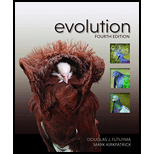
Concept explainers
To determine: A hypothesis to account for the presence of a species of the family Dipterocarpaceae in South America and how it can be tested.
Introduction: The plant family Dipterocarpaceae was thought to be found only in tropical Asia. In tropical Asia, many species of the plant are found to be ecologically dominant species. Recently, it has been found that a new species of the family Dipterocarpaceae inhabits the rainforest of Colombia, which is in the northern South America.
Explanation of Solution
Asia has several species of the family Dipterocarpaceae and they are dominant in Asia. A hypothesis could be suggested to explain the discovery of a tree in northern South America. A series of evolutionary events over a very long period of time and ecological factors, such as dispersal, could lead to the spread of the species into other areas such as Colombia and South America.
Since the species discovered in Colombia is new, it is assumed that a series of evolutions led to it and since Colombia is so far from Asia, it could be assumed that it occurred because of dispersal of seeds. Ecological factors, such as insects, must have been responsible for carrying the seeds so far from their origin. The seeds must have germinated under favorable conditions of the rainforest. Further propagation and colonization of the area must have led to continued survival.
This hypothesis can be proved or tested by the cultivation of a seed from a plant of the species of Dipterocarpaceae under the same environmental conditions as in the rainforest of Colombia. The arborescent and tropical conditions are similar to those needed by the plant. This proves that the plant can grow in the rainforest. It is already known that the seeds of the Dipterocarpaceae family are insect-pollinated. On the basis of both these factors, it can be concluded that the hypothesis suggested is a possible explanation for the presence of a species of the family Dipterocarpaceae in the rainforest of Colombia.
Want to see more full solutions like this?
- Can you described the image? Can you explain the question as well their answer and how to get to an answer to an problem like this?arrow_forwardglg 112 mid unit assignment Identifying melting processesarrow_forwardGive only the mode of inheritance consistent with all three pedigrees and only two reasons that support this, nothing more, (it shouldn't take too long)arrow_forward
- Oarrow_forwardDescribe the principle of homeostasis.arrow_forwardExplain how the hormones of the glands listed below travel around the body to target organs and tissues : Pituitary gland Hypothalamus Thyroid Parathyroid Adrenal Pineal Pancreas(islets of langerhans) Gonads (testes and ovaries) Placentaarrow_forward
- What are the functions of the hormones produced in the glands listed below: Pituitary gland Hypothalamus Thyroid Parathyroid Adrenal Pineal Pancreas(islets of langerhans) Gonads (testes and ovaries) Placentaarrow_forwardDescribe the hormones produced in the glands listed below: Pituitary gland Hypothalamus Thyroid Parathyroid Adrenal Pineal Pancreas(islets of langerhans) Gonads (testes and ovaries) Placentaarrow_forwardPlease help me calculate drug dosage from the following information: Patient weight: 35 pounds, so 15.9 kilograms (got this by dividing 35 pounds by 2.2 kilograms) Drug dose: 0.05mg/kg Drug concentration: 2mg/mLarrow_forward
- A 25-year-old woman presents to the emergency department with a 2-day history of fever, chills, severe headache, and confusion. She recently returned from a trip to sub-Saharan Africa, where she did not take malaria prophylaxis. On examination, she is febrile (39.8°C/103.6°F) and hypotensive. Laboratory studies reveal hemoglobin of 8.0 g/dL, platelet count of 50,000/μL, and evidence of hemoglobinuria. A peripheral blood smear shows ring forms and banana-shaped gametocytes. Which of the following Plasmodium species is most likely responsible for her severe symptoms? A. Plasmodium vivax B. Plasmodium ovale C. Plasmodium malariae D. Plasmodium falciparumarrow_forwardStandard Concentration (caffeine) mg/L Absorbance Reading 10 0.322 20 0.697 40 1.535 60 2.520 80 3.100arrow_forwardPlease draw in the missing answer, thank youarrow_forward
 Biology: The Dynamic Science (MindTap Course List)BiologyISBN:9781305389892Author:Peter J. Russell, Paul E. Hertz, Beverly McMillanPublisher:Cengage Learning
Biology: The Dynamic Science (MindTap Course List)BiologyISBN:9781305389892Author:Peter J. Russell, Paul E. Hertz, Beverly McMillanPublisher:Cengage Learning Biology (MindTap Course List)BiologyISBN:9781337392938Author:Eldra Solomon, Charles Martin, Diana W. Martin, Linda R. BergPublisher:Cengage Learning
Biology (MindTap Course List)BiologyISBN:9781337392938Author:Eldra Solomon, Charles Martin, Diana W. Martin, Linda R. BergPublisher:Cengage Learning Biology Today and Tomorrow without Physiology (Mi...BiologyISBN:9781305117396Author:Cecie Starr, Christine Evers, Lisa StarrPublisher:Cengage Learning
Biology Today and Tomorrow without Physiology (Mi...BiologyISBN:9781305117396Author:Cecie Starr, Christine Evers, Lisa StarrPublisher:Cengage Learning
 Concepts of BiologyBiologyISBN:9781938168116Author:Samantha Fowler, Rebecca Roush, James WisePublisher:OpenStax College
Concepts of BiologyBiologyISBN:9781938168116Author:Samantha Fowler, Rebecca Roush, James WisePublisher:OpenStax College





